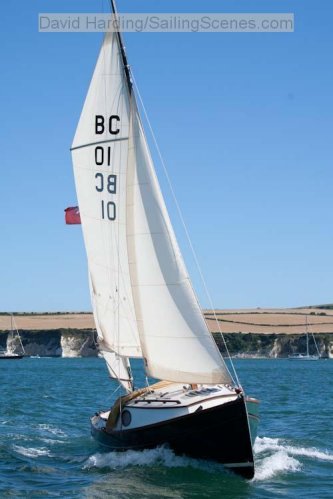This photo is a mosaic of two I took during the English Raid (can you spot the join?), looking down on Daisy G at low tide from the quayside at Keyhaven. I think is gives a very good view of the Baycruiser form. They are really quite beamy, although quite narrow at the waterline. This is partly why they have such high form stability. As soon as she starts to heel, a great chunk of the overhanging side is forced into the water and this in turn pushes buoyantly back. She is very stable even without the water ballast, but rock solid with it.
This photo, taken from the same quayside, shows a comparison between the original Bayraider (Simon Knight's fibreglass
Carpe Diem in this case) and the Baycruiser. They really are quite different. The surrounding bulwark on the BC gives a really nicely enclosed foredeck. There is also no under-sidedeck stowage on the Bayraider, which is so useful on the Baycruiser (see the previous post to see the boathooks stored in this area). On the other hand, it has bigger under bench cockpit lockers on both sides plus a huge storage area under the foredeck. The original proposed cabin verison of the Bayraider was to have just a slightly raised and extended foredeck to form a "camping cuddy". I think there are still plans to pursue this. I wanted a full cabin to use as my Wendy house, as my wife describes it. Simon and I are convinced the Baycruiser is significantly longer than the Bayraider, more than the specified 5 inches, but we never got round to actually measuring them.
This angle also clearly shows the original and revised positions of the jib sheet fairlead tracks. The originals, on the cabin roof, were too close to the centreline, despite Matt insisting that they met all the theoretical design requirements. The new positions on the grab rails are a bit odd looking but work well. I am going to remove the original tracks over the winter.
Just to complete the comparison. This view gives an idea of the different cockpits of the Raider and Cruiser. The under side deck stowage shows up clearly. You can also see my stern ladder in its "deployed" position and the tiller control line, which hooks over a cleat on the under side. Knots in the line stop the tiller slipping and bungees at each end make it easy to whip on and off.
Just to complete the picture, this is the design that started it all, a Searaider, Pelham Olive's
Lattis, tied up alongside
Daisy G at Buckler's Hard. This is a racing boat with twin headsails on a permanent bowsprit, all sorts of adjustment tackles and a tiller controlled by tiller lines aorund the engine well. They even had trapeze wires. But... they had to sleep on board the Thames barge mother ship, whilst my daughter and I slept comfortably aboard
Daisy Grace for five nights. Horses, or boats, for courses.
And finally (is there ever a finally) the one they are all talking about, the
Bayraider 17, under sail and under tow. This is Matt Newland's own boat. I think it is a stunner. It is so sleek and simple inside. I see this as a big seller and a real replacement to the
Drascombe Dabber, which was always my favourite.
The shed builder arrived on site this morning and started sawing bits of wood! Yay!
 I print my onw logpages and keep them in a very thin very old four ring binder (one I originally used for my formula 1 car designs back when Jochen Rindt was my hero. That was a VERY long tome ago). The binder fits into my chart holder, along with a ToughChart collection, so I can reach it from the cockpit. I just record where I have gone, how long it took and how far it was. I used to keep more detail, but decided that was for offshore sailors, which isn't me. On the left is a page from 2010's log showing how it is set out.
I print my onw logpages and keep them in a very thin very old four ring binder (one I originally used for my formula 1 car designs back when Jochen Rindt was my hero. That was a VERY long tome ago). The binder fits into my chart holder, along with a ToughChart collection, so I can reach it from the cockpit. I just record where I have gone, how long it took and how far it was. I used to keep more detail, but decided that was for offshore sailors, which isn't me. On the left is a page from 2010's log showing how it is set out.















































